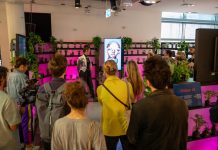In the past, those born both deaf and blind were consigned to a life of limited or non-existent communications – but a research team based at the University of Groningen in The Netherlands in close collaboration with the Royal Dutch Kentalis Deafblindness Center for Excellence – is developing new techniques and strategies to help unlock this
Five senses
The five senses are the gateway for humans interpret and interact with the world around us. But for those born with congenital deafblindness, also known as dual-sensory loss, communication with the world around them is difficult. A diagnosis of congenital deafblindess involves the recognition as that a person has both serious visual and auditory impairments. The causes of deafblindness in newborn children include Down’s Syndrome, CHARGE (a rare condition affecting the whole body), rubella or excessive drug or alcohol use during pregnancy. Whatever the cause, being born with the condition means that individuals struggle to engage with communications and language, with the combination of senses affected posing a unique challenge in communicating and interacting with the outside world. The challenge is twofold, affecting not only the clients but also those who interact with them, including carers and medical professionals.
A unique problem demands a unique solution. Professor Marleen Janssen and a team of seven PHD students are, in the world’s first and only studies concentrating solely on congenital deafblindness and communication, attempting to create strategies and techniques to enable persons with deafblindness to communicate at higher levels. Concentrating on real-life examples, the research could go a long way to unlocking an effective means of communicating for deafblind individuals.
Window to the world
In engaging with the world, the majority of people with deafblindness do not use language and are unable to speak. Instead, their method of interacting with the world is described by Janssen as ‘communication with bodies’; essentially, using bodily movements, postures and hand gestures to express feelings, meanings and desires.The meanings and symbolism of these gestures is unique from client to client and their interpretation requires considerable skill of a carer. Misunderstandings are frequent and can give rise to serious and severe challenges, which can manifest themselves in emotional and behavioural problems. As a result, communication with deafblind individuals rarely moves beyond the superficial level, with makes more abstract communication difficult. It is in this field that Janssen and the PhD students are working. By studying and understanding communication the team hopes to develop high-quality communication methods which will enable caregivers to learn new skills and techniques to facilitate greater communication with clients who are deafblind.
An inter-subjective approach
The project members are calling upon previous theoretical and empirical research to base their projects – some of which was completed by Janssen herself. The studies focus on inter-subjectivity – a conceptual construct used to describe the interactional relationship between individuals. Within the concept, communication is described as having certain layers. At the bottom is basic communications – asking for a drink, for example – with subsequent levels involving higher level and more in-depth and abstract communication. These further levels often involve greater use of symbolic communication and language. The research, conducted entirely by seven PHD students under Janssen’s direction, explores the first, second and tertiary levels of intersubjectivity.
Tested on both children and adults, one project involves understanding and evaluating the way caregivers recognise the emotions of their clients and change their behaviour accordingly. In another study a student is investigating how the caregivers learn to understand and process the various sounds, noises and utterances of the deafblind individuals. A sound or action can have many different meanings, inevitably defined by the context in which they are delivered. The study aims to create new approaches to the problem which will hopefully enable persons with deafblindness to be more spontaneous and communicative in tune with their carer. Additional studies feature practical approaches to develop interventions that will allow deafblind individuals to use tactile initiatives, gestures and signs to aid communications and a process for coaching caregivers into recognising the emotional impressions of their deafblind client.
More accurate diagnosis
Interestingly, often people with deafblindess are misdiagnosed as being autistic or intellectually disabled when this may not actually be the case. This misdiagnosis can mean they receive inappropriate treatment or, in more serious cases, no treatment or support at all. One particular PHD study is attempting to develop a set of guidelines to facilitate the completion of a dynamic assessment procedure for deafblind persons. The belief is that, should their condition be more accurately and appropriately diagnosed, interventions and treatments can be provided that are more applicable, resulting in happier and more engaged clients.
CONTACT
Professor Dr H.J.M. Janssen
Chair of Congenital and Early Acquired Deafblindness
University of Groningen
Department of Special Needs Education and Youth Care Congenital and Early Acquired
Deafblindness
RoyalDutchKentalisCenter for Excellence
PO Box 72
9700 AB Groningen
The Netherlands
T +31 5036 36575
To find out more, visit: www.rug.nl/staff/h.j.m.janssen and www.kentalis.nl/deafblind









